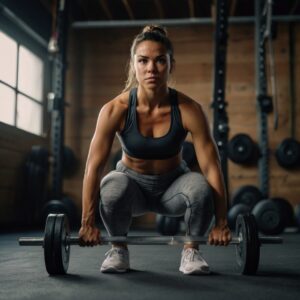Throughout the month, women experience hormonal cycles, and these cycles can greatly influence training and performance. Menstrual cycles and hormonal changes associated with pregnancy are two examples of fluctuations that can have a huge effect on energy levels, muscle recovery, and motivation.
In the first two weeks of the menstrual cycle, known as the follicular phase, a number of women report feeling stronger energy and being more resilient during difficult workouts. It’s an ideal time to tackle that difficult training challenge or focus on building strength and endurance. The luteal phase, following ovulation, may be a time when the body is a little less kind. It’s important to listen to your body and, perhaps, during this period place a greater emphasis on maintenance rather than overloads.
Keeping track of your menstrual cycle and how you feel during different phases can provide powerful knowledge. Use an app that is geared toward athletes or just keep a simple diary. By synchronizing your training with your cycle, you could see improvements in both training efficiency and competition performance.
Osteoporosis is a condition that weakens bones and makes them more fragile. Women are more likely than men to develop it, especially in endurance sports like triathlon. It’s important to make room for strength training in your regimen. Weight lifting plays an important role not only in bone density retention but also in muscle strengthening, which is crucial for injury prevention.
Among the weight-bearing exercises you might include squats and lunges, consider some plyometric ones, which have been shown to help bones grow denser and more resilient strength. Long-term, you’ll get an invaluable service by customizing a program, along with a coach, to fit your individual needs and goals. And don’t avoid the heavier weights—building power and resilience will help you during those powerful biking and running bouts.
Remember that women’s nutritional needs are different from men’s, especially when you consistently burn a lot of calories through training. It’s vital to maintain a well-balanced diet rich in iron, calcium, and other essential vitamins and minerals.
Calcium and vitamin D are critical players in bone health, be sure to pay attention to them, particularly if you’re lactose intolerant or favor non-dairy sources. You might want to think about discussing your choices with a nutritionist who specializes in sports nutrition, so you have a game plan that keeps you energized and strong during training.
Gear Considerations & Comfort
Equipment that doesn’t fit properly can lead to discomfort and even injury. Women often have different body shapes from men, so choosing gear that acknowledges those differences is crucial.
 Make sure your bike is the right size for your frame when buying one. Many brands offer women-specific models these days that take into account common body differences, such as narrower shoulders and longer legs. Make an effort to ride a few bikes and see which one feels the best. Don’t pass up the opportunity for a professional bike fit—this small investment might save you from experiencing discomfort in your neck or back later.
Make sure your bike is the right size for your frame when buying one. Many brands offer women-specific models these days that take into account common body differences, such as narrower shoulders and longer legs. Make an effort to ride a few bikes and see which one feels the best. Don’t pass up the opportunity for a professional bike fit—this small investment might save you from experiencing discomfort in your neck or back later.
Women may have a hard time finding sports bras that provide enough comfort and support without causing chafing. Choosing a high-quality option, especially one that wicks moisture, can make a world of difference on long rides or runs.
Choose tri suits with flat seams to avoid chafing and those that make it easier to move without interruptions between the swimming, biking, and running sections of your race. The right gear should allow you to concentrate more on training and less on handling straps or dealing with irritation.
Women are more susceptible to dehydration and associated problems, particularly because of body composition reasons. Look for hydration packs or systems that you will hardly notice and that will maintain a comfortable fit without interfering with your performance. Choose women’s specific models, as they are often built to allow a close fit and share the load evenly.
Sunglasses and visors protect against the elements while training outdoors. Lightweight, breathable headwear or eyewear, especially those created for women, protects the skin and enhances visibility and comfort on sunny training days.
Mental Strategies for Success
Societal expectations and stereotypes around athleticism can perpetuate self-doubt. Building mental resilience is just as crucial as physical training. Visualization techniques, positive affirmations, and setting small, achievable goals can boost confidence and motivation.
Consider working with a sports psychologist to overcome mental blocks and improve your focus. Mindfulness practices like meditation can also enhance mental clarity and reduce pre-race anxiety. Remember, your mind is an equally powerful tool in achieving triathlon prowess.
Having people who understand your goals and challenges makes a big difference. Engaging in women’s triathlon clubs can also provide a nurturing environment where you learn from shared experiences and motivate each other. These groups often offer invaluable mentorship opportunities, where seasoned athletes offer insights and tips based on their experiences. Having like-minded individuals to train with can also take your performance to new heights, providing encouragement and shared motivation.
Practices such as yoga or simple stretching exercises are ways to relieve stress while enhancing flexibility, which is an important factor in preventing injuries. Allowing sufficient time for rest and recovery is crucial, granting your body the relaxation it needs to perform well.
In a successful triathlon training program, there must be absolute rest days and sleep must be given priority. Understand the signs of overtraining and be prepared to adapt your schedule—this adaptability will maintain balance in both body and mind.
Tackling Common Challenges
Women generally take on multiple jobs. In addition to their training schedules, they have to balance work, family, and personal obligations. So, it is important to learn how to seamlessly incorporate workouts into your daily life. For those with busy schedules, early morning workouts or shorter, high-intensity sessions may be more doable.
Including family in your fitness routine may help with the time issue. Plan a cycling trip on the weekend, or go for a run with friends who serve both as workout partners and a social support system. If fitness becomes part of your lifestyle instead of an undertaking, you will progress steadily without burnout.
At times, female athletes are met with gender bias and stereotyping. Such attitudes can trickle down to personal perceptions and beliefs about performance. By recognizing such biases, you can work to confront and overcome them. Support from the community and role models is crucial to changing this dynamic.
Uplift female athletes’ triumphs around you and share experiences for a more inclusive community. Supporting initiatives for women in sports will bring change and stimulate further participation of women in the triathlon family.
Instead of purely focusing on the ultimate race outcome, set smaller, progressive goals that will give you a sense of accomplishment along the way. Celebrate every success, be it a new personal best or mastering a skill like breathing control in swimming. Introduce new routes and workouts sometimes and fun over performance. Make it your own thing—it could be a new playlist, or intertwining your favorite activities as rewards after milestones.
